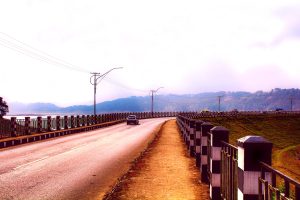Japan has been historically connected to Northeast India for a long time, from the days of World War II when Japanese troops fought alongside troops from Subhas Chandra Bose’s Indian National Army (INA). It is worth mentioning here that it was the INA which had hoisted the Indian flag for the first time at Moirang in Manipur.
Cut to the present times, and Northeast India has become a major part of Japan’s Free and Open Indo-Pacific Vision. Japan is now a major player in the infrastructure sector in Northeast India.
Among other projects, Japan is involved in the Guwahati Water Supply Project, the Guwahati Sewage Project (Assam), the North-East Road Network Connectivity Improvement Project (Assam-Meghalaya), the Project for Renovation and Modernization of the Umiam-Umtru Stage III Hydroelectric Power Station (Meghalaya), the Sustainable Catchment Forest Management Project (Tripura), the Project on Capacity Enhancement for Sustainable Agriculture and Irrigation Development (Mizoram), a forest management project in Nagaland, and the construction of primary schools in Manipur. Total ODA from Japan to Northeast India stood at over 231 billion yen (approximately $2 billion) as of January 2021.
Japan also has an initiative known as the IRIS program, which sends students from India’s Northeast to Japan.
Northeast India is one region of the country that is deficient in quality infrastructure and this is where Japan’s role is critically important. It is worth noting here that both India and Japan have not joined the China-led Belt and Road Initiative (BRI), through which Beijing fund infrastructure development in other countries.
As mentioned earlier, the Northeast in an important part of Japan’s Free and Open Indo-Pacific Vision, which aims to ensure that all countries work together to keep the trade routes in the Indo-Pacific free for all. Already Japan has a big presence in Myanmar and Bangladesh. India’s Northeast is the missing link, which will help Japan bridge the gap.
New Delhi will benefit since the infrastructure in this region has lagged behind and this requires heavy lifting on the part of India. Japan has been providing loans at negligible rates of interest, which helps the Northeast close the gap at minimal cost to New Delhi.
This has also been seen in the case of the Mumbai-Ahmedabad High-Speed Railway project and other projects in India. This is also a chance for India and Japan to provide an alternative to the Chinese model of investment as seen in the BRI.
Meanwhile, Japanese soft power has also found many takers in the region, Meghalaya has been organizing a cherry blossom festival for some time now. Japanese shows, especially anime shows, are increasing in popularity in Northeast India.
At an address in Guwahati, Assam in February 2021, Japanese Ambassador Suzuki Satoshi noted that “Japan always takes a panoramic perspective in its diplomacy. The vision for a free, open and inclusive Indo-Pacific (FOIP) is at its center; and India’s North East, including Assam, occupies an important place in this vision.”
However, there are quite a few challenges to infrastructure development in India’s Northeast. Coordination at the local level between Japanese entities and different states may not be easy. Another limiting factor is that all of the Northeast states are in different stages of development.
In addition, each state has different terrain. For example, Arunachal Pradesh is quite different from, say, Tripura. Overall, though, the terrain in this region is mountainous, and this part of India is also prone to earthquakes, although these are issues Japan is accustomed to dealing with.
Finally, it could be a challenge to execute the projects on schedule, since each one involves coordination between different agencies of the central and regional governments in India, and at the corporate and official levels in Japan.
Be that as it may, Japanese development assistance to Northeast India is here to stay as it is a win-win situation for both.

































